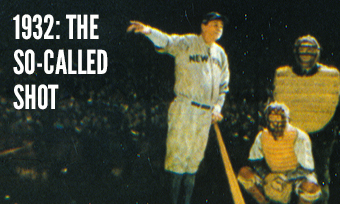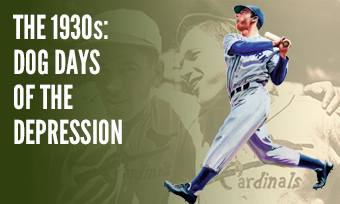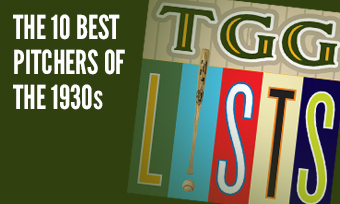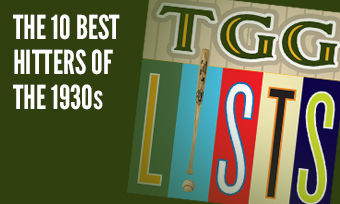The Yearly Reader
Leaders and Honors, 1932
Our list of baseball’s top 10 hitters and pitchers in both the American League and National League for the 1932 baseball season, as well as the awards and honors given to the game’s top achievers of the year.
The National League’s Top 10 Hitters, 1932
Bold type in brick red indicates league leader.
1. Chuck Klein, Philadelphia
Key Numbers: 154 games, .348 average, 152 runs, 226 hits, 50 doubles, 15 triples, 38 home runs, 137 RBIs, 60 walks, 20 stolen bases, .646 slugging percentage.
Klein became the second and last modern league leader in both homers and steals (Jimmy Sheckard, 1903).
2. Mel Ott, New York
Key Numbers: 154 games, .318 average, 119 runs, 30 doubles, 8 triples, 38 home runs, 123 RBIs, 100 walks, .424 on-base percentage.
All but squelched from sharing (or bettering) the home run crown with Chuck Klein in 1929, Ott couldn’t get even as he failed to break a tie with Klein—going homerless in his final six games.
3. Don Hurst, Philadelphia
Key Numbers: .339 average, 109 runs, 196 hits, 41 doubles, 24 home runs, 143 RBIs, 65 walks.
The Baker Bowl effect certainly applied to Hurst, who thanked the good architect for hitting .402 at the Phillies’ home yard.
4. Bill Terry, New York
Key Numbers: 154 games, .350 average, 124 runs, 225 hits, 42 doubles, 11 triples, 28 home runs, 117 RBIs.
Perhaps fueled by anger over a payroll cut—because his batting average ‘dropped’ 52 points from .401 in 1931—Terry powered up to collect a career-high total in home runs, among many other achievements.
5. Lefty O’Doul, Brooklyn
Key Numbers: .368 average, 120 runs, 219 hits, 32 doubles, 8 triples, 21 home runs, 90 RBIs.
Collecting his second batting title in four years, O’Doul finished a mesmerizing stretch in which, from 1929-32, he hit .373.
6. Paul Waner, Pittsburgh
Key Numbers: 154 games, .341 average, 107 runs, 215 hits, 62 doubles, 10 triples, 8 home runs, 82 RBIs, 13 stolen bases.
Though his 62 doubles are not a record, he did set a mark with 20 in one month (May); four of those came at St. Louis on May 20, tying another all-time record.
7. Babe Herman, Cincinnati
Key Numbers: .326 average, 87 runs, 188 hits, 38 doubles, 19 triples, 16 home runs, 87 RBIs, 18 caught stealing, 22 grounded into double plays.
Throwing its hands in the air after failing to come to a contract agreement, Brooklyn sent Herman—along with an unknown catcher named Ernie Lombardi—to the Reds, where he made good on what would turn out to be a one-year tour of duty.
8. Hack Wilson, Brooklyn
Key Numbers: 135 games, .297 average, 37 doubles, 23 home runs, 123 RBIs, 85 strikeouts.
Brushed out of Chicago after a miserable follow-up to his sensational 1930 effort, Wilson experienced a mild resurgence with the Robins before his career crashed again—this time, for good—due to his stubborn habit for the good life off the field.
9. Pinky Whitney, Philadelphia
Key Numbers: .154 games, .298 average, 93 runs, 186 hits, 33 doubles, 11 triples, 13 home runs, 124 RBIs.
Whitney rounded out the trio of Phillies (along with Don Hurst and Chuck Klein) who placed 1-2-3 in the NL RBI race, while pacing the team to its only winning year between 1917 and 1949.
10. Dick Bartell, Philadelphia
Key Numbers: 154 games, .308 average, 118 runs, 189 hits, 48 doubles, 7 triples, 64 walks, 35 sacrifice hits.
The soon-to-be All-Star shortstop for the Giants had his most profitable year in his four years playing for the Phillies—with 34 of his 48 doubles swatted at home.
The American League’s Top 10 Hitters, 1932
1. Jimmie Foxx, Philadelphia
Key Numbers: .364 average, 151 runs, 213 hits, 33 doubles, 9 triples, 58 home runs, 169 RBIs, 116 walks, .749 slugging percentage.
Foxx was robbed on several accounts during the year; he might have matched Roger Maris 29 years in advance with 61 homers, but three of them were turned into ground rule doubles at St. Louis because extra netting—an extension of the outfield wall hung up just a few years earlier—swatted them back. He also didn’t get the triple crown because of Dale Alexander (.367), who under today’s rules would not have had enough plate appearances to qualify. Foxx would make up for that slight the following year.
2. Lou Gehrig, New York
Key Numbers: 156 games, .349 average, 138 runs, 208 hits, 42 doubles, 9 triples, 34 home runs, 151 RBIs, 108 walks, 11 stolen bases.
The first four-homer performance in American League history was the obvious highlight in another stellar year for the Iron Horse.
3. Babe Ruth, New York
Key Numbers: 133 games, .341 average, 120 runs, 41 home runs, 137 RBIs, 130 walks, .489 on-base percentage.
Aging into nothing more than a home run machine at age 37, Ruth collected 40-plus blasts for the seventh straight year.
4. Al Simmons, Philadelphia
Key Numbers: .322 average, 670 at-bats, 144 runs, 216 hits, 28 doubles, 9 triples, 35 home runs, 151 RBIs.
In his final year playing in an A’s uniform before being sold off to the White Sox, Simmons was going to miss playing in Shibe Park; he knocked in 100 of his 151 runs at the ballpark alone.
5. Earl Averill, Cleveland
Key Numbers: .314 average, 116 runs, 198 hits, 37 doubles, 14 triples, 32 home runs, 124 RBIs, 75 walks, 6 hit-by-pitches.
At the peak of his career, Averill might have hit more than the 32 homers listed had the Indians not played 32 of their home games at voluminous Cleveland Stadium (as opposed to the more compact League Park).
6. Heinie Manush, Washington
Key Numbers: .342 average, 121 runs, 214 hits, 41 doubles, 14 triples, 14 home runs, 116 RBIs.
Manush continued to prove to the Senators that they weren’t missing Goose Goslin, dealt to the Browns for himself and workhorse General Crowder a couple of years earlier.
7. Mickey Cochrane, Philadelphia
Key Numbers: .293 average, 118 runs, 35 doubles, 23 home runs, 112 RBIs, 100 walks.
Despite a rare sub-.300 average, Cochrane set career marks in home runs, runs and RBIs while reaching 100 walks for the first time; he struck out just 22 times.
8. Joe Cronin, Washington
Key Numbers: .318 average, 95 runs, 43 doubles, 18 triples, 6 home runs, 116 RBIs, 66 walks.
The vast outfield expanses of Griffith Stadium allowed Cronin to pace the AL in triples for the only time in his career; he hit 13 alone at home.
9. Charlie Gehringer, Detroit
Key Numbers: .298 average, 112 runs, 184 hits, 44 doubles, 11 triples, 19 home runs, 107 RBIs, 68 walks.
For the only time between 1927 and 1940, Gehringer finished with a sub-.300 average after collecting just four hits in his final 24 at-bats of the season.
10. Ben Chapman, New York
Key Numbers: .299 average, 101 runs, 41 doubles, 15 triples, 10 home runs, 107 RBIs, 71 walks, 38 stolen bases, 18 caught stealing.
Chapman led the AL in steals for a second straight year—and for those assuming he was robbing Ruth and Gehrig of an opportunity to hit by leaving first base open, he actually batted behind the two boppers in the lineup.
The National League’s Top 10 Pitchers, 1932
1. Lon Warneke, Chicago
Key Numbers: 2.37 ERA, 22 wins, 6 losses, 25 complete games, 4 shutouts, .786 win percentage, 277 innings.
Warneke more than set the pace to initiate a string of 10 straight winning seasons.
2. Carl Hubbell, New York
Key Numbers: 2.50 ERA, 18 wins, 11 losses, 40 appearances, 32 starts, 284 innings, 40 walks.
In 16 of the 22 games in which Hubbell went the distance, he gave up two or fewer earned runs.
3. Huck Betts, Boston
Key Numbers: 2.80 ERA, 13 wins, 11 losses, 221.1 innings, 35 walks.
Back in the majors for the first time since an unsatisfying first tenure with the Phillies during the early 1920s, the 35-year-old Betts brought more sage and backbone following five solid minor league campaigns for St. Paul in the American Association.
4. Red Lucas, Cincinnati
Key Numbers: 2.94 ERA, 13 wins, 17 losses, 28 complete games, 269.1 innings, 35 walks.
The right-hander from Tennessee authored the best ERA of his 15-year career—but poor support led him to a career-worst number of losses.
5. Watty Clark, Brooklyn
Key Numbers: 3.49 ERA, 20 wins, 12 losses, 40 appearances, 36 starts, 273 innings, 49 walks.
By winning his last seven starts, Clark finally reached the promised land of 20 victories, before imploding over the next two seasons.
6. Ben Cantwell, Boston
Key Numbers: 2.96 ERA, 13 wins 11 losses, 37 appearances, 9 starts, 5 saves, 146 innings, 21 grounded into double plays.
Moved to the bullpen because of his dependability to pitch on short notice, Cantwell still proved he was just as good in the rotation with three straight complete-game victories to finish the year.
7. Larry French, Pittsburgh
Key Numbers: 3.02 ERA, 18 wins, 16 losses, 47 appearances, 33 starts, 274.1 innings, 62 walks.
One of the hardest working pitchers of the time, French finished strong by winning half of his games from mid-August on.
8. Dizzy Dean, St. Louis
Key Numbers: 3.30 ERA, 18 wins, 15 losses, 46 appearances, 33 starts, 4 shutouts, 286 innings, 191 strikeouts.
At 21, Dean made his presence known by becoming an instant threat on the mound—and a pain in the rear to Cardinals management, threatening to bolt at midseason due to a contract he suddenly wasn’t happy with.
9. Steve Swetonic, Pittsburgh
Key Numbers: 2.82 ERA, 11 wins, 6 losses, 4 shutouts.
Local guy makes good, even if briefly; the Mount Pleasant, Pennsylvania native gave up a major league-best .221 opposing batting average in, easily, his best of five big-league seasons.
10. Guy Bush, Chicago
Key Numbers: 3.21 ERA, 19 wins, 11 losses, 40 appearances, 30 starts.
The man with the 15-10 record and 6.20 ERA in 1930 got a slightly more prominent record with half the ERA of two years later.
The American League’s Top 10 Pitchers, 1932
1. Lefty Grove, Philadelphia
Key Numbers: 2.84 ERA, 25 wins, 10 losses, .714 win percentage, 7 saves, 44 appearances, 30 starts, 27 complete games, 4 shutouts, 291.2 innings, 188 strikeouts.
It was a bad year for Grove, but only in relative terms; he lost 10 games for the first time in five years and failed to lead the league in strikeouts for the first time in seven years—but he capped his sixth straight 20-win campaign and his fourth straight AL ERA crown.
2. General Crowder, Washington
Key Numbers: 3.33 ERA, 26 wins, 15 losses, 50 appearances, 39 starts, 327 innings.
Settled back in at D.C.—where he began his career in 1926 before spending roughly three years with the Browns—the General earned his stars as Workhorse of the Year.
3. Red Ruffing, New York
Key Numbers: 3.09 ERA, 18 wins, 7 losses, .720 win percentage, 259 innings, 190 strikeouts, 115 walks.
Ruffing was the guy responsible for knocking Lefty Grove off the top spot of the AL strikeout leaderboard for the first time in seven years.
4. Wes Ferrell, Cleveland
Key Numbers: 3.66 ERA, 23 wins, 13 losses, 38 appearances, 34 starts, 26 complete games, 287.2 innings.
Ferrell became the first, and still the only, pitcher to win at least 20 games in each of his first four years.
5. Mel Harder, Cleveland
Key Numbers: 3.75 ERA, 15 wins, 13 losses, 39 appearances, 32 starts, 254.2 innings, 68 walks.
Consistent if anything else, Harder began an eight-year run in which he won at least 15 games.
6. Ted Lyons, Chicago
Key Numbers: 3.28 ERA, 10 wins, 15 losses, 230.2 innings.
The long-time White Sock, now halfway through his Hall-of-Fame career, deserved better than a 10-15 record—but perspective is everything; the White Sox finished 49-102.
7. Johnny Allen, New York
Key Numbers: 3.70 ERA, 17 wins, 4 losses, .810 win percentage.
The 27-year-old rookie didn’t waste time grabbing more than his share of wins, something he’d luck out on throughout much of his career—and that was a good thing given his temperamental attitude.
8. Lefty Gomez, New York
Key Numbers: 4.21 ERA, 24 wins, 7 losses, .774 win percentage, 37 appearances, 31 starts, 265.1 innings.
Proving life isn’t fair, Gomez put together an ERA one run higher than Lyons but attached it to a much better record thanks to run support that was nearly double per start.
9. Monte Weaver, Washington
Key Numbers: 4.08 ERA, 22 wins, 10 losses, 43 appearances, 30 starts, 234 innings.
It was a sterling rookie effort for Weaver, but it would be his best effort as a switch to a vegan diet would take the power out of his pitching game in later years.
10. Vic Sorrell, Detroit
Key Numbers: 4.03 ERA, 14 wins, 14 losses, 31 starts, 13 complete games, 234.1 innings.
A .500 record seemed on brand for a pitcher who continually posted competent but average numbers on paper throughout his career—yet only four AL hurlers in 1932 had a better WHIP (walks and hit allowed per inning).









